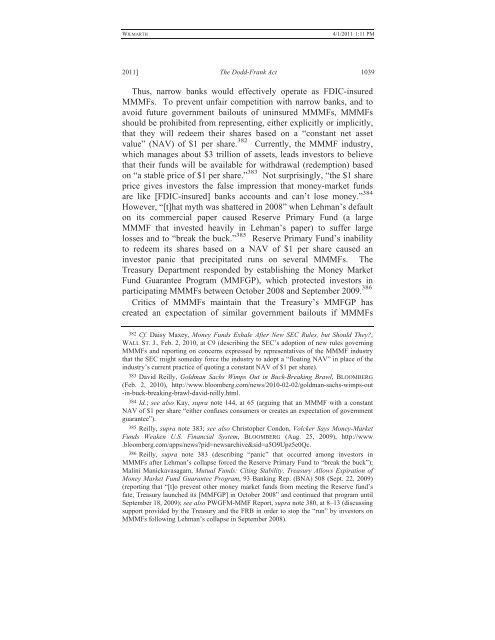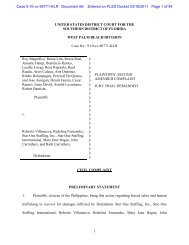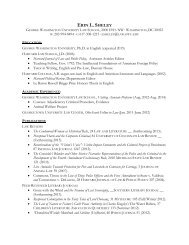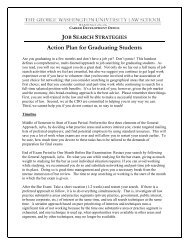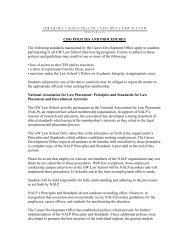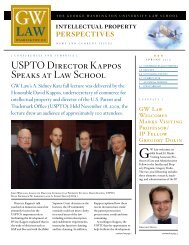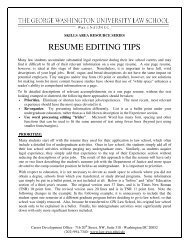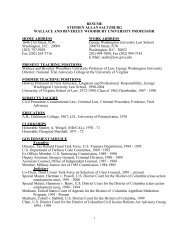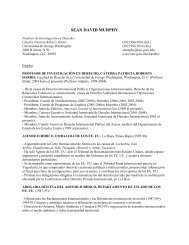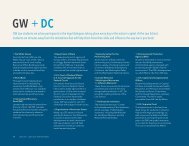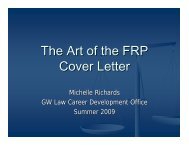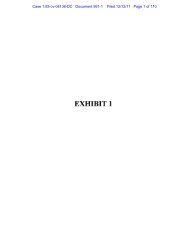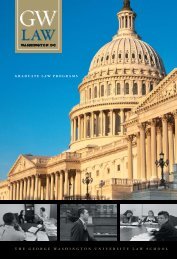CLE Materials for Panel #1 - George Washington University Law ...
CLE Materials for Panel #1 - George Washington University Law ...
CLE Materials for Panel #1 - George Washington University Law ...
You also want an ePaper? Increase the reach of your titles
YUMPU automatically turns print PDFs into web optimized ePapers that Google loves.
WILMARTH<br />
4/1/2011 1:11 PM<br />
2011] The Dodd-Frank Act 1039<br />
Thus, narrow banks would effectively operate as FDIC-insured<br />
MMMFs. To prevent unfair competition with narrow banks, and to<br />
avoid future government bailouts of uninsured MMMFs, MMMFs<br />
should be prohibited from representing, either explicitly or implicitly,<br />
that they will redeem their shares based on a “constant net asset<br />
value” (NAV) of $1 per share. 382 Currently, the MMMF industry,<br />
which manages about $3 trillion of assets, leads investors to believe<br />
that their funds will be available <strong>for</strong> withdrawal (redemption) based<br />
on “a stable price of $1 per share.” 383 Not surprisingly, “the $1 share<br />
price gives investors the false impression that money-market funds<br />
are like [FDIC-insured] banks accounts and can’t lose money.” 384<br />
However, “[t]hat myth was shattered in 2008” when Lehman’s default<br />
on its commercial paper caused Reserve Primary Fund (a large<br />
MMMF that invested heavily in Lehman’s paper) to suffer large<br />
losses and to “break the buck.” 385 Reserve Primary Fund’s inability<br />
to redeem its shares based on a NAV of $1 per share caused an<br />
investor panic that precipitated runs on several MMMFs. The<br />
Treasury Department responded by establishing the Money Market<br />
Fund Guarantee Program (MMFGP), which protected investors in<br />
participating MMMFs between October 2008 and September 2009. 386<br />
Critics of MMMFs maintain that the Treasury’s MMFGP has<br />
created an expectation of similar government bailouts if MMMFs<br />
382 Cf. Daisy Maxey, Money Funds Exhale After New SEC Rules, but Should They?,<br />
WALL ST. J., Feb. 2, 2010, at C9 (describing the SEC’s adoption of new rules governing<br />
MMMFs and reporting on concerns expressed by representatives of the MMMF industry<br />
that the SEC might someday <strong>for</strong>ce the industry to adopt a “floating NAV” in place of the<br />
industry’s current practice of quoting a constant NAV of $1 per share).<br />
383 David Reilly, Goldman Sachs Wimps Out in Buck-Breaking Brawl, BLOOMBERG<br />
(Feb. 2, 2010), http://www.bloomberg.com/news/2010-02-02/goldman-sachs-wimps-out<br />
-in-buck-breaking-brawl-david-reilly.html.<br />
384 Id.; see also Kay, supra note 144, at 65 (arguing that an MMMF with a constant<br />
NAV of $1 per share “either confuses consumers or creates an expectation of government<br />
guarantee”).<br />
385 Reilly, supra note 383; see also Christopher Condon, Volcker Says Money-Market<br />
Funds Weaken U.S. Financial System, BLOOMBERG (Aug. 25, 2009), http://www<br />
.bloomberg.com/apps/news?pid=newsarchive&sid=a5O9Upz5e0Qc.<br />
386 Reilly, supra note 383 (describing “panic” that occurred among investors in<br />
MMMFs after Lehman’s collapse <strong>for</strong>ced the Reserve Primary Fund to “break the buck”);<br />
Malini Manickavasagam, Mutual Funds: Citing Stability, Treasury Allows Expiration of<br />
Money Market Fund Guarantee Program, 93 Banking Rep. (BNA) 508 (Sept. 22, 2009)<br />
(reporting that “[t]o prevent other money market funds from meeting the Reserve fund’s<br />
fate, Treasury launched its [MMFGP] in October 2008” and continued that program until<br />
September 18, 2009); see also PWGFM-MMF Report, supra note 380, at 8–13 (discussing<br />
support provided by the Treasury and the FRB in order to stop the “run” by investors on<br />
MMMFs following Lehman’s collapse in September 2008).


